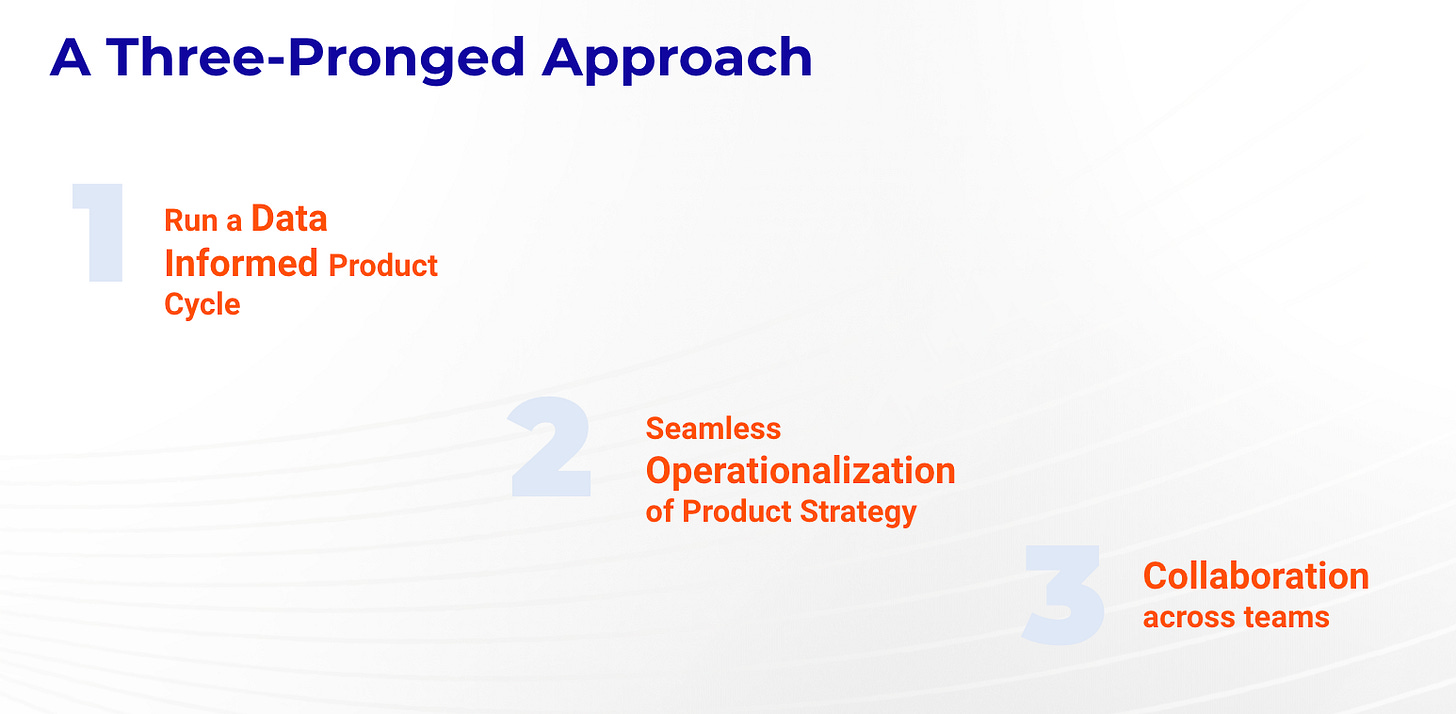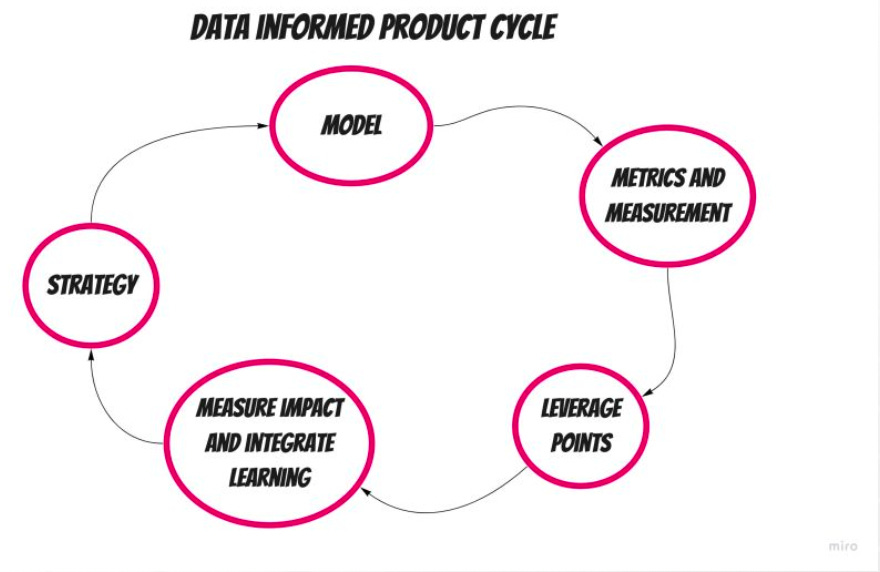In addition to my role as a Product Management leader, I’ve also been running and maturing the Product Ops organization at Mindtickle for close to 2 years now. I’ve been asked many times on what the role entails, how to be successful at it and why is it gaining importance. This post is about my understanding of the role/ function is, and some of my personal experiences running this part of the org.
What is Product Ops?
ProductOps aims to solve problems for product teams that single teams and individuals cannot solve.
It sits at the intersection of product, design, engineering, and customer success, Sales, Product Marketing and exists to support the R&D team and their go-to-market counterparts to improve alignment, communication, and processes around product development, launch, and iteration.
ProductOps can help identify areas for improvement, inform business decisions, and provide product insights. The specific responsibilities of ProductOps can vary depending on the needs of the business and the biggest gaps in terms of org/process.
Need for Product Ops
For SaaS companies, the product isn’t just part of the customer experience — IT is the experience. From trial and purchase all the way through onboarding, expansion, and referrals, the product becomes the single point of success or failure for all of those stages. And product ops are central to the optimization of that experience, especially as the product development lifecycle continues to evolve.
The increasing availability of data has led to the "datafication" of everything, prompting organizations to recognize the importance of using data for business decisions. As a result, analyzing data and turning it into actionable insights has become an essential operational function. Product data, in particular, is considered the cleanest data in any organization (there is no manual messing around with it) and can have a significant impact on the business.
According to Gartner, by 2021, 75% of software providers will rely on insights from embedded software analytics to inform product decisions and measure customer health.
To ensure the effectiveness of a data-driven product strategy, a strong foundation is necessary to ensure that the data is accurate, comprehensible, and useful.
As teams build and release more, how do they know if they’re building the right things? And how do they ensure users know about everything they’re building? That’s where we see product ops coming in: optimizing the product development process and the customer experience to ensure users get value from the product, and internal teams are educated and enabled to do their jobs efficiently.
Product ops typically sits in the product management team or in an adjacent function that also reports up to the head of product.
I look at the role of product ops in running a 3 pronged approach effectively.
#1. Run a Data-Informed Product Development cycle
Most teams jump from high-level vision/goals straight to feature ideas (w/ "success metrics") The most successful teams run a data-informed product development cycle.
I have leveraged this framework by John Cutler in defining a data-informed Product cycle
Have a product strategy
Translate that into models
Layer in the Metrics & Measurements
Identify leverage points
Measure Impact and Integrate Learning
Have a Strategy
Product Ops along with Product & Product Marketing can work together to build the foundations of a solid product strategy and eventually leading upto Product Roadmaps. This is detailed in my post about Building Data-driven product roadmaps
Good strategy has a simple logical structure
(1) a clear-eyed diagnosis of the challenge being faced,
(2) an overall guiding policy explaining how the challenge will be met, and
(3) a set of coherent actions designed to focus energy and resources. (Rumelt)
Develop a context appropriate model
Models help orient us and encourage more effective conversations. Customer LTV models, journey maps, North Star Framework, and Retention Models. They help orient us, and encourage more effective conversations. Most organizations skip developing a product strategy, and use models that aren’t very actionable for actual product work (e.g. high-level financial inputs/outputs). We don’t want that. If we skip strategy and models, we’ll end up with a bunch of roadmaps filled with features.
Layer in Metrics and Measurement
Have you ever looked at an executive dashboard filled with charts (or spreadsheet filled with numbers), and had no clue how it all fit together? What were the metrics trying to proxy? How were they related?
When we start with models, we can take a different approach. Given our various models, how do we measure the things that really matter?
Measurements can be across various areas, and has to be brought into the right context
Product stickiness
DAU/MAU ratio,
WAU/MAU ratio
Product usage
Breadth (e.g. number of active users for a given customer)
Depth (e.g. feature usage)
Frequency (e.g. number of logins for a given customer)
Feature adoption rates
Feature retention rates
Leading indicators of conversion, renewal, and expansion
NPS
Top feature requests
Product delivery predictability
Product bugs (e.g. broken down by feature and product usage)
Product performance
Support tickets
Customer feedback
User research data
Win/loss analysis
Churn data
Cost data
Revenue data
These are just starting points, you could also run specific initiatives to identify who your best customers are based on product usage, what are they doing differently that the vast majority, what outcomes they are seeing as key metrics on platform and therefore in their business, how can you replicate similar outcomes for your larger customer base?
Then there are churn prediction models , and based on what features are showing up as most important in protecting churn, product teams can act on how to make sure there is good discovery built around them.
Identify Leverage Points
Using our product lens, a leverage point might be a stage in a funnel, a variable we think we can improve by 2x, an unexplored flywheel, a bunch of small usability issues that add up, or even an area of curiosity that might help us unravel a longstanding product mystery.
Measure Impact and Integrate Learning
When that thing “ships”, we set about understanding how it impacted things that matter (our various models, and strategy). We Measure Impact. Finally, we Integrate Whatever We Learn back into our strategy and models!
#2. Seamless Operationalization of Product Strategy
Product Ops plays a crucial role in operationalizing product strategy by ensuring that the product development process is aligned with the overall business strategy and goals. Product Ops teams work to streamline the product development process by identifying and eliminating inefficiencies in the process. This can include improving communication channels, identifying bottlenecks, and implementing tools to help teams collaborate more effectively.
#3. Collaboration across teams
Processes will differ depending on how teams are structured, but it’s imperative for product ops to align with other teams across the company, and be the inter-departmental link that drives collaboration around the product. By providing product insights, product ops works with other teams to identify areas for improvement and inform business decisions.
Of course the value of this data hinges on it reaching the right people at the right time. Product ops needs to set up effective workflows and cadences for delivering this information (and avoid just fielding one-off requests) — for example, supplying product usage data to customer success, allowing them to pre-identify at-risk accounts.
Product ops is a key partner for teams like RevOps, CS, product marketing, sales, engineering and of course, the wider product team. These relationships will vary by company, but here’s what it could look like:
Working with marketing to hone persona definitions, ensuring the leads generated match the characteristics of the company’s most successful users.
Aligning with RevOps to ensure product data is incorporated into business health metrics, especially with respect to trial conversions, renewals, and expansions
Monitoring customer feedback channels and then feeding that information back to the CS team and product owners. Working with CS on expansion opportunities and churn protection, of customers.
Defining performance experience metrics in partnership with the quality assurance team to better measure success around the product experience.
As companies scale, there’s a need for leadership to have enough information to make decisions, especially when it comes to decisions about the product. The product ops team (or leader) is a key advisor for CPOs, VPs of product, and other R&D leadership of the like — for example, by using data to advise on the roadmap or supplying product health data to the executive team.
Product ops needs to be able to get leadership the data that they need to make product decisions, not just the data they ask for.
What makes for a successful product ops person?
If you’re thinking about hiring a product ops person (or team), think of these as the characteristics to look for. And if you’re wondering if you may be a product ops practitioner in hiding, use this list to self-assess to see if you’re a good fit for the role.
They need to be comfortable working with systems
Product ops people should be good at understanding and using (which often includes learning) a variety of tools in their day-to-day. They need to enable product teams on tools across the product stack
They need to be proficent with data
Product Ops folks should be experts in converting data into valuable insights and tell a story with it
They need to be effective communicators
The product ops role is going to be sharing information to many different teams, all the time. They need to build great relationships across the org and effectively communicate all the time.
Have strong Business sense
Since product ops connects the product with a company’s business priorities, sound business judgement is an important foundational skill to look for.
They are a Collaborative tissue across the org
Collaboration is another top skill - the ability to be a “catalyst”: someone who can be put into a group of people and make the whole group more collaborative.
Have good Product sense
Product ops people don’t necessarily have to have a product management background, but they should have a fairly good product sense
Be Entrepreneurial
There will times when they will make 0 to 1 journeys, get buy in across the org for initiatives, and need to be comfortable with ambiguity in general.
Be a Leader
Not every product ops role will have direct reports, but they need to have a scaled impact across different functions of the business, which requires them to be leaders in their own right.
Overall, the goal of a Product Ops team is to ensure that the product development process is aligned with the overall business strategy and goals and that all teams are working together effectively to achieve those goals. By operationalizing product strategy, Product Ops teams help ensure that the product is meeting customer needs, driving business value, and contributing to the overall success of the company.
I am passionate about building and running A+ ProductOps teams, so if you have questions, feel free to drop me a note on parekh.shweta@gmail.com








Is product ops different than Program management ? If yes what are the differences? Where do these two functions overlap?